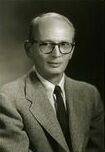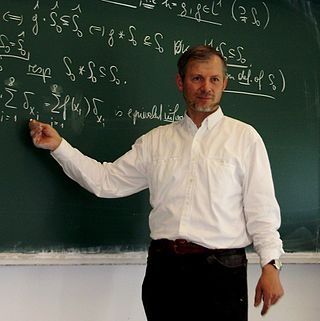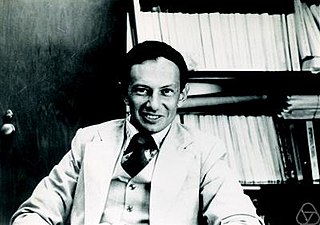Harmonic analysis is a branch of mathematics concerned with investigating the connections between a function and its representation in frequency. The frequency representation is found by using the Fourier transform for functions on the real line, or by Fourier series for periodic functions. Generalizing these transforms to other domains is generally called Fourier analysis, although the term is sometimes used interchangeably with harmonic analysis. Harmonic Analysis has become a vast subject with applications in areas as diverse as number theory, representation theory, signal processing, quantum mechanics, tidal analysis and neuroscience.

Elias Menachem Stein was an American mathematician who was a leading figure in the field of harmonic analysis. He was the Albert Baldwin Dod Professor of Mathematics, Emeritus, at Princeton University, where he was a faculty member from 1963 until his death in 2018.

Lars Valter Hörmander was a Swedish mathematician who has been called "the foremost contributor to the modern theory of linear partial differential equations". Hörmander was awarded the Fields Medal in 1962 and the Wolf Prize in 1988. In 2006 he was awarded the Steele Prize for Mathematical Exposition for his four-volume textbook Analysis of Linear Partial Differential Operators, which is considered a foundational work on the subject.

Charles Louis Fefferman is an American mathematician at Princeton University, where he is currently the Herbert E. Jones, Jr. '43 University Professor of Mathematics. He was awarded the Fields Medal in 1978 for his contributions to mathematical analysis.

Salomon Bochner was an Austrian mathematician, known for work in mathematical analysis, probability theory and differential geometry.

Terence Chi-Shen Tao is an Australian mathematician. He is a professor of mathematics at the University of California, Los Angeles (UCLA), where he holds the James and Carol Collins chair. His research includes topics in harmonic analysis, partial differential equations, algebraic combinatorics, arithmetic combinatorics, geometric combinatorics, probability theory, compressed sensing and analytic number theory.

Lennart Axel Edvard Carleson is a Swedish mathematician, known as a leader in the field of harmonic analysis. One of his most noted accomplishments is his proof of Lusin's conjecture. He was awarded the Abel Prize in 2006 for "his profound and seminal contributions to harmonic analysis and the theory of smooth dynamical systems."
Louis Auslander was a Jewish American mathematician. He had wide-ranging interests both in pure and applied mathematics and worked on Finsler geometry, geometry of solvmanifolds and nilmanifolds, locally affine spaces, many aspects of harmonic analysis, representation theory of solvable Lie groups, and multidimensional Fourier transforms and the design of signal sets for communications and radar. He is the author of more than one hundred papers and ten books.

Sigurdur Helgason is an Icelandic mathematician whose research has been devoted to the geometry and analysis on symmetric spaces. In particular, he has used new integral geometric methods to establish fundamental existence theorems for differential equations on symmetric spaces as well as some new results on the representations of their isometry groups. He also introduced a Fourier transform on these spaces and proved the principal theorems for this transform, the inversion formula, the Plancherel theorem and the analog of the Paley–Wiener theorem.
In harmonic analysis, a field within mathematics, Littlewood–Paley theory is a theoretical framework used to extend certain results about L2 functions to Lp functions for 1 < p < ∞. It is typically used as a substitute for orthogonality arguments which only apply to Lp functions when p = 2. One implementation involves studying a function by decomposing it in terms of functions with localized frequencies, and using the Littlewood–Paley g-function to compare it with its Poisson integral. The 1-variable case was originated by J. E. Littlewood and R. Paley and developed further by Polish mathematicians A. Zygmund and J. Marcinkiewicz in the 1930s using complex function theory. E. M. Stein later extended the theory to higher dimensions using real variable techniques.
Adolf Edward Nussbaum was a German-born American theoretical mathematician who was a professor of mathematics at Washington University in St. Louis for nearly 40 years. He worked with others in 20th-century theoretical physics and mathematics such as J. Robert Oppenheimer and John von Neumann, and was acquainted with Albert Einstein.

Hans Georg Feichtinger is an Austrian mathematician. He is Professor in the mathematical faculty of the University of Vienna. He is editor-in-chief of the Journal of Fourier Analysis and Applications (JFAA) and associate editor to several other journals. He is one of the founders and head of the Numerical Harmonic Analysis Group (NuHAG) at University of Vienna. Today Feichtinger's main field of research is harmonic analysis with a focus on time-frequency analysis.

Michael Grain Crandall is an American mathematician, specializing in differential equations.

Joseph Albert Wolf is an American mathematician. He is now professor emeritus at the University of California, Berkeley.

Cora Susana Sadosky de Goldstein was a mathematician and Professor of Mathematics at Howard University.
Peter Larkin Duren was an American mathematician. He specialized in mathematical analysis and was known for the monographs and textbooks he has written.
Robert Edmund Edwards (1926–2000), usually cited simply as R. E. Edwards, was a British-born Australian mathematician who specialized in functional analysis. He is the author of several volumes in Springer's Graduate Texts in Mathematics.

Kenneth Irwin Gross was an American mathematician.
Guy David is a French mathematician, specializing in analysis.

M. Vali Siadat is an Iranian-American mathematician, the Distinguished Professor of Mathematics at Richard J. Daley College.













